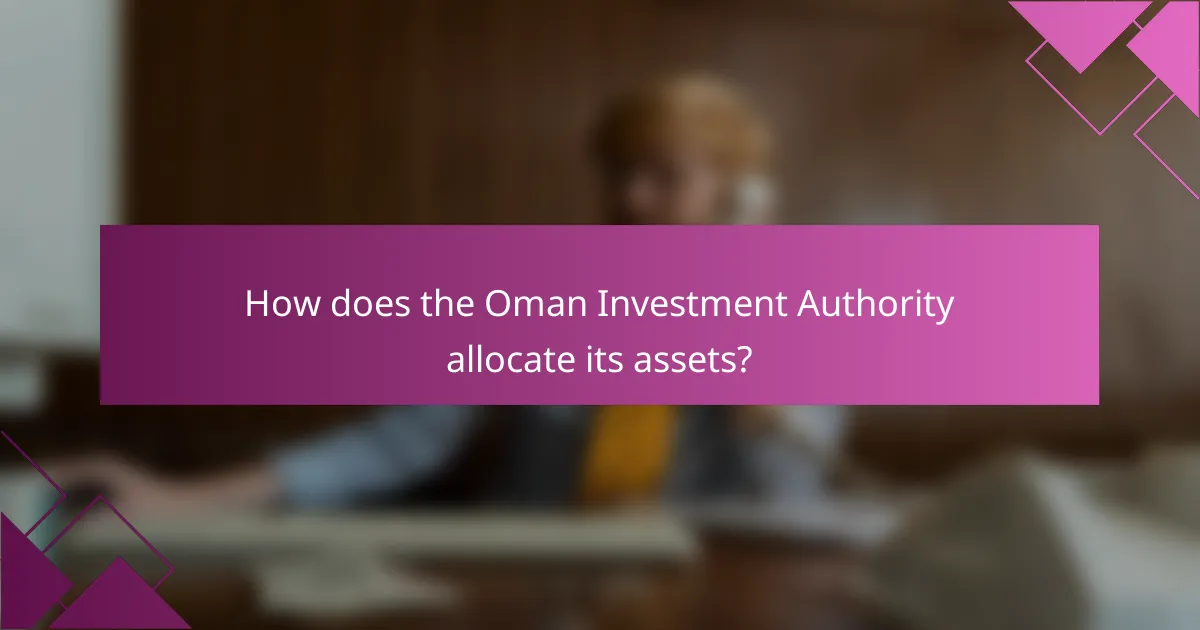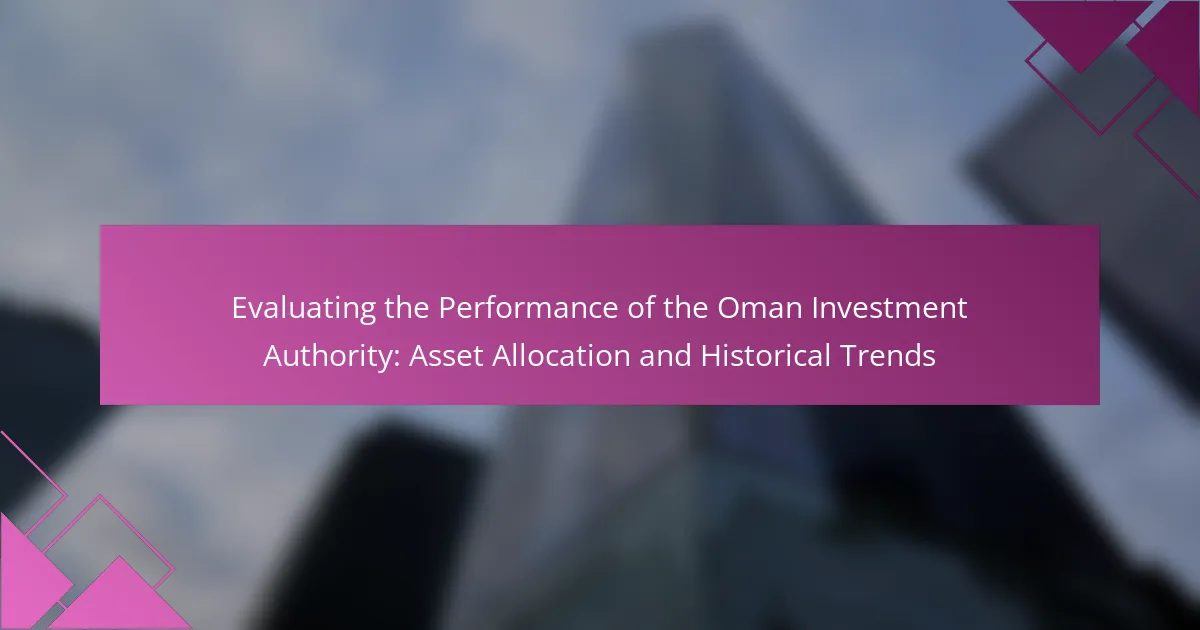
What is the Oman Investment Authority?
The Oman Investment Authority is the sovereign wealth fund of Oman. It was established to manage the nation’s assets and investments. The authority aims to diversify the economy and enhance the country’s financial sustainability. It operates under the Ministry of Finance and focuses on both domestic and international investments. The Oman Investment Authority manages a portfolio that includes various sectors such as real estate, infrastructure, and financial services. Its establishment reflects Oman’s strategy to invest surplus revenues from oil and gas. The authority plays a crucial role in the economic development of Oman.
How was the Oman Investment Authority established?
The Oman Investment Authority was established in 2020. It was formed by merging the Oman Sovereign Wealth Fund and the Oman Investment Fund. This consolidation aimed to enhance investment strategies and governance. The authority focuses on diversifying the Sultanate’s economy. It seeks to invest in both domestic and international markets. The establishment aligns with Oman’s Vision 2040 economic diversification plan. This plan emphasizes sustainable economic growth and development.
What are the key objectives of the Oman Investment Authority?
The key objectives of the Oman Investment Authority include diversifying the national economy and maximizing long-term returns on investments. The Authority aims to enhance the value of public investments. It focuses on sustainable development and promoting economic growth. Another objective is to support strategic sectors within Oman. The Authority also seeks to attract foreign direct investment. It aims to foster partnerships with global investors. Additionally, the Oman Investment Authority emphasizes responsible investment practices. These objectives align with the broader goals of economic diversification outlined in Oman’s Vision 2040.
Who are the stakeholders involved in the Oman Investment Authority?
The stakeholders involved in the Oman Investment Authority include the Omani government, local businesses, and international investors. The Omani government is the primary stakeholder, as it owns and governs the authority. Local businesses benefit from investments that stimulate economic development. International investors engage with the authority for potential investment opportunities. Additionally, various regulatory bodies oversee the authority’s operations. These stakeholders collectively influence the strategic direction and investment decisions of the Oman Investment Authority.
What is the role of the Oman Investment Authority in the economy?
The Oman Investment Authority plays a crucial role in the economy by managing the Sultanate’s sovereign wealth fund. It invests in various sectors to promote economic diversification and sustainable growth. The authority aims to enhance the country’s financial stability and generate long-term returns. It also supports local projects and initiatives that align with national development goals. Additionally, the Oman Investment Authority contributes to job creation and technological advancement through its investments. Its strategic asset allocation focuses on both domestic and international opportunities. As of 2023, the authority manages assets exceeding $18 billion, reflecting its significant impact on the economy.
How does the Oman Investment Authority contribute to national development?
The Oman Investment Authority contributes to national development by managing and diversifying the Sultanate’s sovereign wealth. It invests in strategic sectors such as infrastructure, energy, and tourism. These investments create jobs and stimulate economic growth. The authority also aims to enhance the country’s global competitiveness. It supports initiatives that promote sustainable development and innovation. In 2020, the authority reported investments exceeding $10 billion in various sectors. This financial commitment underscores its role in national development. The authority aligns its strategies with Oman Vision 2040, aiming for a diversified economy.
What sectors does the Oman Investment Authority focus on?
The Oman Investment Authority focuses on various sectors including infrastructure, logistics, tourism, and technology. These sectors are critical for economic diversification in Oman. The authority aims to enhance the country’s investment landscape. It seeks to attract foreign investments in these areas. The focus on infrastructure supports national development goals. Logistics improvements facilitate trade and connectivity. Tourism initiatives aim to boost economic growth. Technology investments foster innovation and digital transformation.

How does the Oman Investment Authority allocate its assets?
The Oman Investment Authority allocates its assets across various sectors and geographies. It focuses on both domestic and international investments. The authority diversifies its portfolio to manage risk effectively. Key sectors include real estate, infrastructure, and financial services. It also invests in equities and fixed income instruments. The asset allocation strategy aims to achieve long-term growth and stability. In 2021, the authority reported a significant portion of its investments in sustainable and responsible projects. This approach aligns with global investment trends and national economic goals.
What are the primary asset classes in the Oman Investment Authority’s portfolio?
The primary asset classes in the Oman Investment Authority’s portfolio include equities, fixed income, real estate, and alternative investments. Equities represent a significant portion, focusing on both local and international markets. Fixed income investments provide stable returns through government and corporate bonds. Real estate investments diversify the portfolio with properties in key global locations. Alternative investments encompass private equity and venture capital, aiming for higher returns. This diversified approach helps manage risk and enhance overall portfolio performance.
How does the Oman Investment Authority diversify its investments?
The Oman Investment Authority diversifies its investments through strategic asset allocation across various sectors and geographies. This includes investments in infrastructure, real estate, and financial markets. The Authority emphasizes both domestic and international opportunities to mitigate risk. It also invests in emerging markets to capture growth potential. By balancing its portfolio, the Authority aims to achieve stable returns. Historical data indicates that this diversification strategy has helped manage volatility effectively. The approach aligns with global best practices in investment management.
What criteria does the Oman Investment Authority use for asset selection?
The Oman Investment Authority uses several criteria for asset selection. These include potential for long-term growth, alignment with national economic objectives, and risk management considerations. The authority assesses market conditions and sector trends to identify viable investment opportunities. Additionally, they evaluate the financial performance and governance of potential investees. The authority also prioritizes investments that contribute to job creation and economic diversification in Oman. This multi-faceted approach ensures a balanced and strategic asset portfolio.
What historical trends can be observed in the asset allocation of the Oman Investment Authority?
The asset allocation of the Oman Investment Authority has shown a trend towards diversification over the years. Historically, the authority has shifted its investments from predominantly local assets to a more global portfolio. This shift includes increased allocations to international equities, real estate, and alternative investments.
In the early years, the focus was largely on domestic infrastructure and government bonds. However, recent strategies emphasize risk management and return optimization. For instance, data from 2020 indicated a significant increase in the allocation to foreign investments, reflecting a response to global market dynamics.
Additionally, the authority has been adjusting its exposure to sectors such as technology and renewable energy, aligning with global investment trends. This evolution indicates a proactive approach to asset management, aiming to enhance long-term growth and sustainability.
How have global economic conditions influenced asset allocation decisions?
Global economic conditions have significantly influenced asset allocation decisions. Economic growth rates affect investor confidence and risk appetite. In times of strong growth, investors may favor equities over bonds. Conversely, during economic downturns, there is a shift towards safer assets like government bonds. Inflation rates also play a critical role; higher inflation often leads to increased interest rates, which can depress bond prices and alter asset allocation. Additionally, geopolitical events can create uncertainty, prompting a reallocation towards more stable investments. Historical data shows that during the 2008 financial crisis, many investors moved assets into cash and gold, reflecting a flight to safety. Thus, global economic conditions directly impact investment strategies and portfolio diversification.
What changes have occurred in the asset allocation strategy over the years?
The asset allocation strategy of the Oman Investment Authority has evolved significantly over the years. Initially, the focus was predominantly on domestic investments, particularly in the oil sector. Over time, there has been a gradual shift towards diversification. This shift includes increased allocations to international equities and fixed-income securities. The aim has been to mitigate risks associated with oil price volatility.
Recent strategies emphasize sustainable investments and environmental, social, and governance (ESG) factors. The authority has also adopted a more dynamic approach to asset allocation. This includes periodic reviews and adjustments based on market conditions. Data from the Oman Investment Authority’s annual reports indicates these strategic changes have improved overall portfolio performance.

What are the performance metrics used to evaluate the Oman Investment Authority?
The performance metrics used to evaluate the Oman Investment Authority include return on investment (ROI), portfolio diversification, and asset allocation efficiency. ROI measures the profitability of investments made by the authority. Portfolio diversification assesses the risk exposure across various asset classes. Asset allocation efficiency evaluates how well the authority distributes its investments to maximize returns while minimizing risks. These metrics provide a comprehensive view of the authority’s investment performance and strategic effectiveness.
How does the Oman Investment Authority measure investment performance?
The Oman Investment Authority measures investment performance through a combination of financial metrics and benchmarks. It analyzes returns on investment against specific market indices. The authority also considers risk-adjusted returns to assess investment efficiency. Additionally, it evaluates the performance of individual assets within its portfolio. This includes monitoring cash flow, capital appreciation, and overall portfolio diversification. Regular reports and assessments are conducted to ensure alignment with strategic goals. The authority benchmarks its performance against global standards to ensure competitiveness. These methods provide a comprehensive view of investment success and areas for improvement.
What benchmarks are used for comparison?
The benchmarks used for comparison include various financial indices and peer group performance metrics. Common benchmarks for investment authorities are the MSCI World Index and the S&P 500. These indices provide a standard for measuring investment performance. Additionally, the Oman Investment Authority may compare its returns against regional sovereign wealth funds. Historical trends in asset allocation are also assessed using these benchmarks. Performance against these benchmarks helps gauge the effectiveness of investment strategies. Accurate comparison requires consistent measurement periods and methodologies. This ensures a fair evaluation of performance relative to the benchmarks.
How do external factors impact performance evaluations?
External factors significantly impact performance evaluations by influencing the context in which evaluations occur. Economic conditions, such as inflation and market volatility, directly affect asset performance. For instance, during economic downturns, investment returns may decline, leading to lower performance ratings. Regulatory changes can also alter the evaluation landscape, imposing new compliance requirements that may affect operational efficiency. Additionally, competitive pressures from other investment entities can shift performance benchmarks. Research shows that organizations often adjust their evaluation criteria based on these external influences to remain relevant and effective. Thus, these factors create a dynamic environment that shapes how performance is assessed.
What lessons can be learned from the historical performance of the Oman Investment Authority?
The historical performance of the Oman Investment Authority reveals several key lessons. First, diversification is crucial for mitigating risks. The Authority’s varied asset allocation across sectors has historically reduced volatility. Second, long-term investment strategies yield better returns. The Authority’s focus on sustainable growth has proven beneficial over time. Third, adapting to global economic changes is essential. The Authority’s responsiveness to market trends has improved its resilience. Lastly, transparent governance enhances investor confidence. The Authority’s commitment to accountability has strengthened its reputation. These lessons underscore the importance of strategic planning and adaptability in investment management.
What best practices can enhance the investment strategy moving forward?
Diversifying the investment portfolio is a best practice that can enhance the investment strategy moving forward. This approach reduces risk by spreading investments across various asset classes. Historical data shows that diversified portfolios tend to perform better over time compared to concentrated investments. Regularly reviewing and rebalancing the portfolio is also essential. This ensures alignment with financial goals and market conditions. Utilizing data analytics can provide insights into market trends and investment performance. Incorporating sustainable investments can attract a broader range of investors. Lastly, engaging with financial experts can offer valuable perspectives and guidance on complex investment decisions.
How can future challenges be addressed based on past performance trends?
Future challenges can be addressed by analyzing past performance trends. The Oman Investment Authority can utilize historical data to identify successful strategies. For instance, reviewing asset allocation outcomes helps in understanding risk management. Historical trends reveal which sectors performed well during economic downturns. Data from previous investments can guide future decisions. By recognizing patterns, the authority can mitigate potential risks. Additionally, past performance metrics can inform adjustments in investment strategies. This approach enhances the likelihood of achieving desired financial outcomes.
What practical tips can be applied for effective asset management in similar entities?
Implementing effective asset management involves several practical tips. First, establish clear investment objectives aligned with the entity’s overall strategy. This ensures that all asset allocation decisions support the long-term vision. Second, diversify the investment portfolio across various asset classes and geographical regions. Diversification reduces risk and enhances potential returns. Third, regularly review and rebalance the portfolio to maintain alignment with investment goals. This practice helps to adjust for market fluctuations and changing economic conditions. Fourth, utilize data analytics to inform decision-making. Data-driven insights can lead to more informed investment choices. Finally, engage in continuous education and training for the management team. Staying updated on market trends and investment strategies is crucial for effective asset management. These strategies have been shown to enhance performance in similar investment entities, as evidenced by successful asset management practices globally.
The Oman Investment Authority is the sovereign wealth fund of Oman, established to manage the nation’s assets and diversify its economy. This article evaluates the Authority’s performance through its asset allocation strategies and historical trends, highlighting its key objectives, stakeholder involvement, and contributions to national development. It examines the sectors the Authority focuses on, the criteria for asset selection, and the impact of global economic conditions on its investment decisions. Additionally, the article discusses performance metrics used to evaluate the Authority and outlines best practices for enhancing its investment strategies moving forward.
